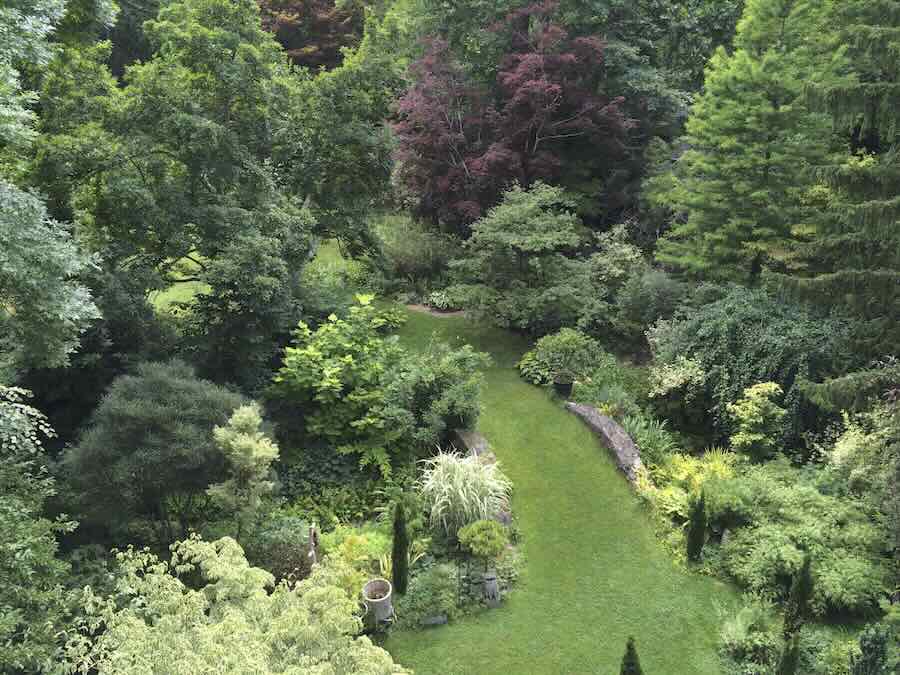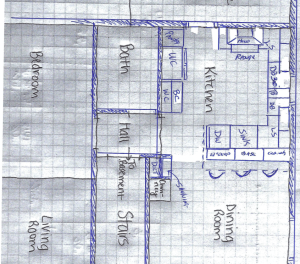
WHAT’S ONE of the best sources of inspiration and information about gardening you can get outside of a classroom, and that is also wonderfully entertaining? By making time to go visit other people’s gardens, we can open ourselves up to lots of learning. And on the flip side of that equation, opening our own gardens to visitors can be a pretty educational experience, too.
It’s peak garden-visiting season, and my friend Ken Druse is here to talk about being a garden tourist and a garden host. (Above, visitors recently asking questions at Ken’s garden.)
Ken Druse is familiar to all of you as a regular guest on this podcast and my co-host of our Virtual Garden Club online class series. And he’s also the author of 20 garden books. He gardens in New Jersey, where he also welcomes visitors for the occasional tour, and he’s a regular garden visitor himself.
Read along as you listen to the June 17, 2024 edition of my public-radio show and podcast using the player below. You can subscribe to all future editions on Apple Podcasts (iTunes) or Spotify (and browse my archive of podcasts here).
 visiting gardens, and welcoming visitors, with ken druse
visiting gardens, and welcoming visitors, with ken druse
Margaret Roach: Hi, Ken. How are you?
Ken Druse: Hi, Margaret. I’m recovering from having a tour a couple of weeks ago.
Margaret: A recovering host, O.K. Is there a support group for that?
Ken: There better be. Maybe it’s gardening. I’m not sure. Well, I used to get so freaked out about having a tour. Well, I’ve had four gardens, I was thinking about that, over the years and when guests are coming, which is not that common because I don’t have parking thankfully. But I used to get so freaked out: “It has to be perfect. It has to be perfect.” And this last time I thought, “You know what? They’re going to like it anyway. And there’s lots of plants to see.” And this was a relatively small group from the Mid-Atlantic Hardy Plant Society, and they love plants, and I’ve got plants, so maybe they’ll ignore the weeds; maybe.
Margaret: Right. And on that topic sort of, recently I did a “New York Times” garden column with the Garden Conservancy, which puts on the largest garden visiting program in this country. They have several hundred gardeners and 30-something-thousand visitors visit them each year. It’s different gardens every year and so forth around the country. And they’ve been doing that since 1995.
And so I called up a bunch of hosts around the country and talked to people about just what you and I are beginning to speak about now. And one of the things I asked everybody was, “What do you do about the stuff that doesn’t look perfect?” [Laughter.] “Do you just worry or do you try to disguise it, or whatever?” And everyone had their own answer.
But one of the things that I used to do in an area that was like I’d never had gotten to yet or whatever, I would put up a sign on a bamboo stake, make a cardboard sign by hand and say, “What’s going on here?” And then I’d put something they could read that would say, “I didn’t get to this because the plants didn’t arrive yet for the blah blah that I’m going to plant here,” or whatever’s going on, or “I planted these last spring and they haven’t grown yet,” or whatever it was.
Ken: Mm-hmm.

Ken: Well, and I think that people identify with that. They’re not going to a public garden with 12—-not that that many gardens have 12 staff, but some do—I mean, you’re a person.
Margaret: Right, right. And so it makes them feel-
Ken: They’re people, too.
Margaret: Right. So it’s a little more accessible and identifiable. Yeah. Definitely.
Ken: The morning of the tour, the very morning, 6:30 AM, an incredible storm came through. It lasted about an hour, and it was 2 inches of rain in about an hour, 60 mile-an-hour winds and hail and things got smashed. And what could I do? I mean, I went around staking what I could, but I figured, well, the reason these are smashed, everybody knew there was a storm. So it happens to them; it happens to me.
Margaret: Right. No, it’s true. And of course, that was one of the other things that all the hosts I spoke to, we all commiserated about, concurred, is that you worry about the weather, the weather, the weather. A few days from when you and I are taping this conversation, I have an event coming up for a local charity and the forecast is for rain. And that’s always a drag, right?
And it’s hard not only on the people who want to come visit, and on the host and so forth, but it’s hard on the garden too. If it’s wet and muddy and then hundreds of feet, human feet I mean, are tromping around. You know what I mean? It’s hard then for things to spring back afterward. Things get more beat up when they’re soggy and muddy.
Ken: Or at all, really. Kiss the paths goodbye. [A grass pathway at Ken’s, above.]
Margaret: Yes. No more paths. So let’s talk about though, I mean, you’re an avid gardener; you’ve seen lots and lots and lots of gardens. You’ve done 20 books. Part of your career has been going around photographing gardens and seeing gardens for other reasons as well. But you’ve visited lots and lots and lots of gardens. And by the way, this is the third week in a row that that house wren has decided he wants to be on the show, and so he’s talk and talk and talk. Sorry about that. My friend here, my friend who’s living on the side of the house.
So yeah, there’s a lot to recommend doing this, despite the worries about the weather, or if you’re a host or whatever. Or if you’re a visitor, the idea of, “Oh, I should be home in my own garden doing my weeding. I shouldn’t leave. I should be home weeding.” But really, there’s so much to learn, isn’t there? There’s so much to get out of it, on either end.
Ken: You’re saying all this, I’m thinking, I don’t think I ever visited a garden ever that I didn’t like, or didn’t see something, or learn something, or talk to the people. I mean, there’s something at every single one. And if there’s small, who cares? Well, there’s always something. I didn’t even realize that till just now. Have I even ever seen a bad garden? Not really.
Margaret: Right, because there’s always ideas. There’s always a plant that you don’t know or have or whatever.
Ken: Oh my gosh, a plant I don’t know. If I meet a plant that I can grow, that’s my zone, if I’m visiting a garden in my area or in my zone, as I said, well, I’m just excited thinking about it. And there is always something. And you said something to learn, too. I get a tip from every garden I visit and especially from gardeners. And I was thinking when we were talking about having this, I visited a garden in New York State, and the owner is, it’s funny, do I say owner, like with dogs? The caretaker, the keeper of the garden, had the most beautiful Pulmonaria.
And when my Pulmonaria, which is lungwort, although no one says that, it blooms very early for me, like April, with blue flowers, mostly have blue flowers, and a few have dark pink flowers. And after mine bloom, the leaves turn black or have black spots, and those little shriveled things. And her Pulmonaria were beautiful. And I said, “How come?” And she said, “Oh, well, I cut it back to 1 or 2 inches right after it blooms.” And I’ve done that ever since. And it produces an incredible flush of new growth. And for Pulmonaria, the flowers are wonderful, but the foliage, now lasts the entire season, and it used to not. So that’s a big tip.

And speaking of what they’re looking at, the thing that cracks me up is I’ll be at my table [above], where I check people in and I answer questions and stuff, I kind of stay at my station, so to speak, throughout the event. And I’ll stare out, suddenly look across the yard or whatever, and I see somebody and they’re taking a picture and I’m thinking, “What are they taking a picture of? There’s nothing over there that they’re pointing the camera at. What in the world are they looking at?”
And mind you, this is my garden, and I ought to know what the heck’s over there [laughter] in the sight line of their camera. But the idea of different sets of eyes and how other people see the same thing and how beneficial that can be. Not only was that person seeing something that they wanted to record, and I don’t know what it was or why, that they want to note and maybe was going to help them with something. But I was like, later I went over there and looked and thought, “Oh, O.K., I see. There’s sort of this viewshed through that little spot where this shrub in that shrub uh-huh, interesting. Maybe I should put something….” So yeah.
And so a lot of us garden alone or it’s a lot of it’s in our heads, and it’s great to have an audience also sometimes.
Ken: I call that the third eye.
Margaret: Yeah. Yeah.
Ken: There’s so many things that you’re used to and you ignore. And you were saying that taking a picture. I used to carry, well, I always still carry a notebook if I can, but now I’ve got the phone. So I take a picture of the plant and if there’s a label, I don’t have to even write it down. And you don’t pick up that label, just leave it where it is, and if you can take a picture of it. And then you’ve got the plant name.

So I think the visiting of private gardens, is a different scale and a different experience. And I just think it’s so important to see how other people are handling familiar and unfamiliar plants and design ideas.
I’m always fascinated by gardens with different rooms. Do you know what I mean? How people make space, delineate space. Even though it’s all outdoors, and there’s no actual walls, how they’ve created individual spaces. And I’m always very admiring and almost envious of that ability to sort of delineate different experiences within the same outdoor space.
That’s something that you see it in the big famous gardens of England in the picture books and stuff like that, or if you go garden visiting in England to historic gardens. But I love seeing when people do that at home, make rooms.
Ken: I think that’s almost one of the hardest things to do for yourself without that kind of input, because I guess you’re just too close to be able to have a bird’s-eye view. And when you visit a garden and see, “Oh, that hedge,” or “This path,” or “I’ve been directed this way,” or “Look how that goes.” Just there’s so much to learn from, especially private gardens, really.
Margaret: Right.
Ken: Now you’re going to have a tour?
Margaret: And you just had one. Right?
Ken: Right. So when you prepare for a tour, there’s so much to think about. But I was trying to think, what are some of the things that you can do to sort of cheat it a little bit, like edging. Edging is getting a haircut or washing your car, there’s so much. Or vacuuming. All of a sudden things are so much better. Edging. What are some of the things that you would put on a list of things to do to prepare for a tour? I’m putting you on the spot.
Margaret: Yeah, no. Well, I do think you’re onto it. I mean, I think that the edging and applying a fresh layer of mulch. And by that I don’t mean burying your plants under 6 inches. I don’t mean something that’s detrimental to anything. I mean just a little thin extra coating to have it look fresh and clean. Going around and cleaning up those edges, where by this time in the season, by late spring, self-sowns and so forth may start to pop up around those edges and make edges fuzzy, or the grass may be overrunning the edges. And whether you sort of cut an edge with a step-on half-moon edger tool, which I do in the beginning of the season, or whether you just sort of by hand go around and pull off some of the shaggy grass or whatever. Or some people use their weed whip tool kind of upside-down, sideways-ish. Do you know what I mean?
Ken: Yeah, I do.
Margaret: Yeah. Everyone has their way of cleaning up that edge. I think that, and a little bit of fresh mulch at the outer parts toward the boundary between bed and whether it’s lawn or patio, hardscape, or whatever. I think that a big difference. Clean edges, you’re absolutely right, I think that’s the Number 1.

Margaret: Right, right. No, I think that’s a good idea.
Ken: Years ago, people used to come and they didn’t really behave [laughter]. Well, one thing that people used to always do is they would come to this garden, turn their back on my garden and talk about themselves or talk about a plant they had. And I used to get so kind of angry at that, but I realized that they’re connecting with me. They’re connecting with the garden. They’re, “I have that, too.” Or they’re so excited to see a plant that they have, too. And I always thought, “There’s a big garden behind you; turn around.” But then they don’t do it so much anymore.
I think people really know now that they tour gardens a lot and because of the Garden Conservancy too. And years ago, you would never charge for someone on a tour. It was always free. But now it’s either for a charity. No one ever complains. It’s for a good cause. When I was in New Zealand years ago, I met these people who worked so hard to open their garden to the public, and they’d done it every year. And I asked them, “Why do it this again? You’re killing yourselves.” And they said, “Well, it’s the box. We are doing it partially because of the box.” And they had a box at the driveway, and they made almost $20,000 from donations in this small town.
Margaret: Oh my goodness.
Ken: So anyway, I think in the United States, people are used to contributing a bit.
Margaret: Right, right.
Ken: To a good cause.
Margaret: Yeah, absolutely. Absolutely. I’ve gone on garden open days, sort of visiting stuff, in England, and there’s a donation at each place and so forth, so it makes sense. Yeah. Again, I just think of it, you were just using that example of the people who would turn around and talk to you as opposed to look at the garden. And I think there’s that, they feel a kindred sense, and they’re so happy to be in the presence of another gardener and get to talk shop, so to speak. And there’s common ground, even if you don’t know each other; there’s common ground right away.
And I mean, it’s always kind of fun each time, depending on when the tour happens, what the plant of the week is, so to speak. That a hundred people will ask about the same plant, because there’s always some plant that’s looking extra-crazy at that time, or an unfamiliar plant that’s showing off or whatever, and people want to know what it is. So there’s always the most asked about, right?
Ken: Right. Absolutely.
Margaret: Yeah. And I’m noticing it used to be around this time of year in this sort of early June period, if I would have an open day going back even 20 or more years, Chionanthus, the fringe tree [detail above], they were not that familiar to people, and people would always ask. It has a wonderful fragrance, and people would be like, “What are those? What’s that fragrance?” And Chionanthus would be one. And now they’re much more familiar. And also by the way, they bloom earlier because everything’s like two weeks ahead of where it was five or 10 years ago,
Ken: At least two weeks ahead. Looking at the garden this year, I’ve changed zones. Absolutely. I’ve never had so many roses. I’ve never had so many roses. All sorts of things are blooming their heads off or doing really well. The leaves are big. It’s really… The world has changed, my world anyway, because everything’s gotten earlier. I used to say the peak of the garden for a tour was the 23rd of May. Now I think it’s the 11th of May.
Margaret: Yeah.
Ken: On the 10th of May, the Trillium would peak. Now it’s almost April 10th.
Margaret: Yes. Yeah, it’s crazy.
Ken: It’s two weeks earlier.
Margaret: Yeah. The early part is really getting early, I think because the winter is not as tenacious. It’s not 3 feet of frost in the ground kind of tenacious for months. It’s kind of tepid compared to a good old-fashioned Northeastern winter. So yeah, it’s very different. So figuring out when to have the events and so forth is quite nervous-making now. Are you going to visit any gardens coming up? Do you have any plans to be doing any garden visiting?
Ken: Not exactly, but I will. I’m not coming to you. You’re too far away.
Margaret: O.K.
Ken: Or I hate when people say, “Oh, I’ve been to that garden,” and I’m thinking, “Goodness.”
Margaret: Right? Because every day is different, and every year is different.
Ken: Every year. “Oh, I saw that garden.” No, no, you didn’t. It was 10 years ago.
Margaret: Yeah. I mean, the other thing that everybody spoke about when I interviewed people for the Times story about Open Days recently was that—and I totally related to it, and I’m sure you will, too—is that by committing to open your garden next year, it’s stressful, it’s pressure. You hear the clock ticking, right? Because again, there’s always those unfinished projects and things in process. But it also gives you a deadline. And there’s nothing like a deadline to make you get stuff done. So I think it makes us more productive. And everyone I talked to, all the hosts I spoke to talked about how it was a motivator.
Ken: Absolutely.
Margaret: They appreciated it. It was good for them. It’s like making a commitment to something can really motivate you. So even if it’s going to just be a small group of friends or whatever, to put on the calendar to have people over: I think there’s a lot of benefits to doing that. Not only is it socially fun potentially. Not only can they see some things that may stimulate ideas for them. But you may learn something too, like we’ve been talking about. But also, again, it’s a motivator to kind of set you on a schedule for your garden management leading up to that time, I think.
Ken: Even if you haven’t had a garden tour, you may have been on a house tour. It’s the same kind of thing. You may end up painting a room. It’s, as you said, a motivator: Get in shape.
Margaret: Yeah. No, I think, and again, even the Garden Conservancy Open Days, it’s not all big fancy estates or anything like that. That’s not the idea. It’s private gardens, and there are all kinds of sizes and all kinds of ages. I spoke to one couple in California whose garden was only a couple of years old around their condominium in Palm Springs, and they were like, “Oh, no, the hedges haven’t even grown in yet,” and blah, blah, blah. But people loved that because people were like, “Oh, what size plants did you start with? And how long ago was that and how long will it take?”
They said you could see people computing projects they now dreamed of doing themselves at their nearby houses because it was like they could see the DIY and the timeline in it, because it wasn’t all a 50-year-old estate with a big staff and everything. It was more they could see that the people had done a lot of the work themselves, and more recently, and they liked that.
Ken: Well, even though it’s stressful, etc., having an open day and having people tour, you get feedback. And sometimes you get marvelous feedback and you get an audience. And so much of what we do is for an audience, and sometimes we don’t even have an audience, but when we do and when we hear people say, when we hear them gasp or even just ask a question, we can connect too. And we get a lot of wonderful feedback and people thank us.
Margaret: Right? Well, I mean, you use a lot of columnar things in your garden, and that’s something that you can talk about it, but when you see it in action, it’s different.
Ken: Oh sure.
Margaret: You kind of get it. And so that’s one thing, for instance, that it would make me gasp to see. You come upon that, and it’s very imposing and it’s very dramatic. So I bet you a lot of people go home from an event at your place and research columnar trees and shrubs and so forth [laughter], because it makes a strong impression.
Ken: I think when I’m in the garden here, I’m always close up, well, when you’re weeding and stuff. But I’m looking at one plant and another plant, another plant, and I don’t get to take a step back until I have that third eye, until I can see the reaction in other people’s eyes and faces and I think, “Oh, that’s working,” or, “I see what they see.” They can see the whole picture. That bird’s eye view we wish we had,

Ken: Well, we talked a tiny bit about don’t talk about yourself or don’t talk about your plants. But years ago, people didn’t behave so well, or someone would bring a stroller.
Margaret: Oh, yeah [laughter].
Ken: I talked to friends and they said people brought a blanket and a picnic lunch, but that doesn’t happen anymore. Or dogs. Even if you love dogs, dogs shouldn’t come on the garden tour with you.
Margaret: Right. The etiquette, there’s all the etiquette stuff. Right? In England, they know better the etiquette than American garden visitors sometimes seem to know.
Ken: And Hawaiian shirts. Don’t compete with the flowers [laughter].
Margaret: Right? Wear muted colors and solids. That’s funny.
Ken: Really, this last group. I guess, you know what I would say too, is if you can meet the gardener, say something. Even though you may be close to speechless because of what you’re seeing, ask a question or congratulate the gardener.
Margaret: Engage, right.
Ken: Yeah. Engage.
Margaret: Engage, right. Yeah. Well, it’s good to talk about garden visiting and being a garden host with you, Ken. As I said, I have mine coming up, so I better go outside and pull some more weeds and clean up some more edges [laughter].
Ken: I may encourage you to not just sit at the table [laughter].
prefer the podcast version of the show?
MY WEEKLY public-radio show, rated a “top-5 garden podcast” by “The Guardian” newspaper in the UK, began its 15th year in March 2024. It’s produced at Robin Hood Radio, the smallest NPR station in the nation. Listen locally in the Hudson Valley (NY)-Berkshires (MA)-Litchfield Hills (CT) Mondays at 8:30 AM Eastern, rerun at 8:30 Saturdays. Or play the June 17, 2024 show using the player near the top of this transcript. You can subscribe to all future editions on iTunes/Apple Podcasts or Spotify (and browse my archive of podcasts here).
 visiting gardens, and welcoming visitors, with ken druse
visiting gardens, and welcoming visitors, with ken druse






